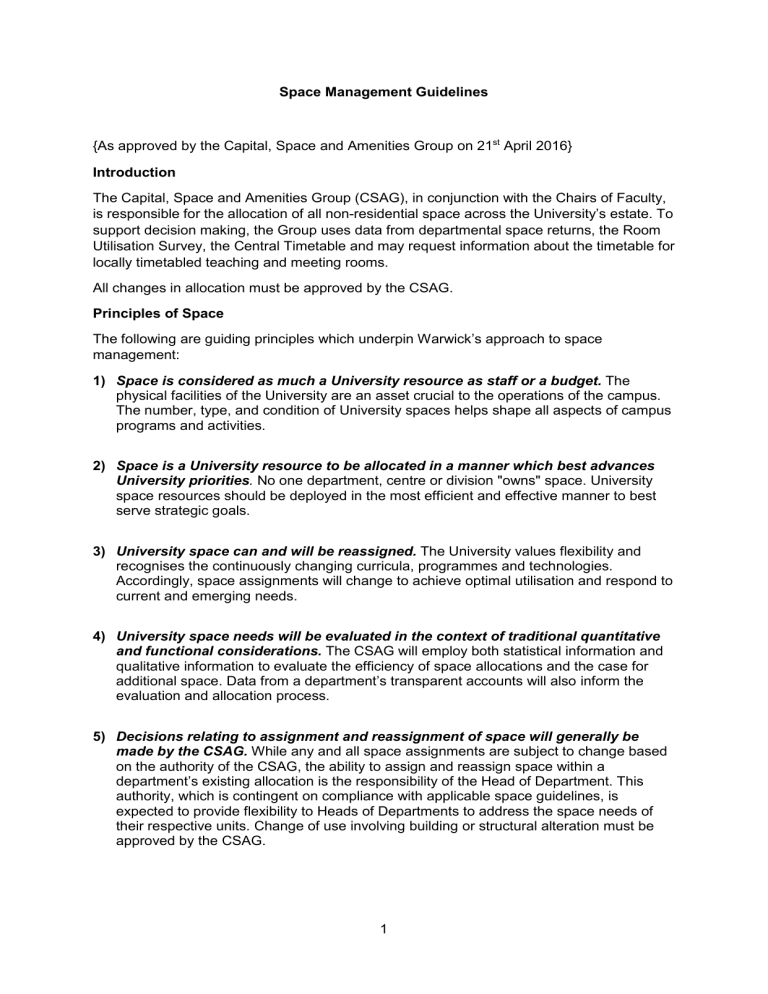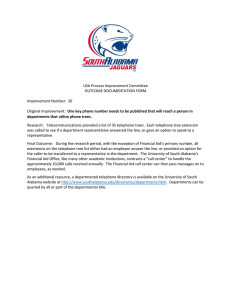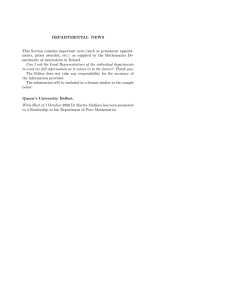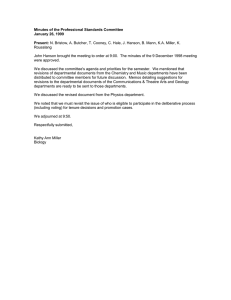{As approved by the Capital, Space and Amenities Group on... April 2016} Space Management Guidelines

Space Management Guidelines
{As approved by the Capital, Space and Amenities Group on 21 st April 2016}
Introduction
The Capital, Space and Amenities Group (CSAG), in conjunction with the Chairs of Faculty, is responsible for the allocation of all non-residential space across the University’s estate. To support decision making, the Group uses data from departmental space returns, the Room
Utilisation Survey, the Central Timetable and may request information about the timetable for locally timetabled teaching and meeting rooms.
All changes in allocation must be approved by the CSAG.
Principles of Space
The following are guiding principles which underpin Warwick’s approach to space management:
1) Space is considered as much a University resource as staff or a budget. The physical facilities of the University are an asset crucial to the operations of the campus.
The number, type, and condition of University spaces helps shape all aspects of campus programs and activities.
2) Space is a University resource to be allocated in a manner which best advances
University priorities.
No one department, centre or division "owns" space. University space resources should be deployed in the most efficient and effective manner to best serve strategic goals.
3) University space can and will be reassigned. The University values flexibility and recognises the continuously changing curricula, programmes and technologies.
Accordingly, space assignments will change to achieve optimal utilisation and respond to current and emerging needs.
4) University space needs will be evaluated in the context of traditional quantitative and functional considerations.
The CSAG will employ both statistical information and qualitative information to evaluate the efficiency of space allocations and the case for additional space. Data from a department’s transparent accounts will also inform the evaluation and allocation process.
5) Decisions relating to assignment and reassignment of space will generally be made by the CSAG.
While any and all space assignments are subject to change based on the authority of the CSAG, the ability to assign and reassign space within a department’s existing allocation is the responsibility of the Head of Department. This authority, which is contingent on compliance with applicable space guidelines, is expected to provide flexibility to Heads of Departments to address the space needs of their respective units. Change of use involving building or structural alteration must be approved by the CSAG.
1
Guidelines for Allocations
New Buildings
The University Estate Committee has approved Space Norms for all new buildings. All new major capital projects are expected to comply with the Space Norms, including extensions, new builds and substantial refurbishments. Exceptions to the Space Norms will only be permitted due to extenuating circumstances and must be approved by the CSAG.
Summary of Space Norms approved by the University Estate Committee
Space Norm
Academic Office
Space: Academic
Staff (appointed to the level of
Assistant Professor and above).
Academic Office
Space: Research
Staff m² per person Notes up to 12
(Where 10 or less is achieved, a seminar
/ meeting space is to be provided for every 8 rooms) up to 6
(typically excludes informal meeting / collaborative space.
A starting point for this would be 1m² per person)
Recommendation based on:
- space for 1600 x 800 mm desk with office chair and under-desk pedestal.
- a focus on excellent and efficient storage provision including space for a tambour cupboard and plenty of shelving.
- space for whiteboard / noticeboard.
- space for visitor chairs and a small meeting table.
- design to allow for future flexibility (non-loadbearing partitions, fire-strategy considerations, provision of services).
Note: consideration to be given to adequate provision of bookable small meeting rooms and seminar spaces for accommodating groups of three people or more.
Recommendation based on allowance for:
- space for 1600 x 800mm desk with office chair and under-desk pedestal.
- space for efficient storage and filing facilities.
- space for shared printers and other office equipment.
Note: the space allowance typically excludes informal meeting / collaborative spaces (except in larger openplan environments). It is imperative that space for these is factored in as appropriate to each user-group, along with factoring in space for meeting rooms, quiet working rooms, tea points and kitchen facilities as necessary. The space and efficiency savings made by staff working in a shared office environment should allow for thoughtful provision of shared facilities to enhance performance, collaboration and enjoyment of the space.
2
Academic Office
Space: Teaching
Only Staff up to 6
(typically excludes informal meeting / collaborative space.
A starting point for this would be 1m² per person)
Recommendation based on allowance for:
- space for 1600 x 800mm desk with office chair and under-desk pedestal.
- space for efficient storage and filing facilities.
- space for shared printers and other office equipment.
Note: the space allowance typically excludes informal meeting / collaborative spaces (except in larger openplan environments). It is imperative that space for these is factored in as appropriate to each user-group, along with factoring in space for meeting rooms, quiet working rooms, tea points and kitchen facilities as necessary. The space and efficiency savings made by staff working in a shared office environment should allow for thoughtful provision of shared facilities to enhance performance, collaboration and enjoyment of the space.
Academic Office
Space: Postgraduate
Research Student /
Doctoral Training
Centre
Non-Academic
Office Space: Non-
Academic deskbased Staff, including
Department Offices and Central
Administrative
Space
4
(per workspace not per student) up to 6
(typically excludes informal meeting / collaborative space.
A starting point for this would be 1m² per person)
Recommendation based on allowance for:
- 1.5 no. of PGRs per workspace based on hotdesking
- 1400 x 800mm desk with office chair per workspace
- lockers (a greater provision than the no. of desks in each room)
- circulation space
- space for a shared printer
Note: in larger spaces this recommended space provision will allow for a meeting table / small breakout space, in smaller rooms it will not. Therefore, provision of meeting / break-out space may need to be considered in buildings which are cellular in nature.
Recommendation based on allowance for:
- space for 1600 x 800mm desk with office chair and under-desk pedestal.
- space for efficient storage and filing facilities.
- space for shared printers and other office equipment.
Note: the space allowance typically excludes informal meeting / collaborative spaces (except in larger openplan environments). It is imperative that space for these is factored in as appropriate to each user-group, along with factoring in space for meeting rooms, quiet working rooms, tea points and kitchen facilities as necessary. The space and efficiency savings made by staff working in a shared office environment should allow for thoughtful provision of shared facilities to enhance performance, collaboration and enjoyment of the space.
3
Other Staff Space:
Meeting Room
Other Staff Space:
Common Space
Teaching Space:
Teaching Room /
Seminar Room
Teaching Space:
Lecture Theatre
Laboratory Space:
Wet Research
Laboratory
Laboratory Space:
Dry Research
Laboratory including
Computer
Laboratories
Laboratory Space:
Wet Teaching
Laboratory
2
All staff should have access to a common space
2 to 2.3
The norm is to assist with the adequate sizing of meeting rooms (it is not a provision of meeting room space allocated per member of staff). The recommendation allows for a comfortable arrangement of furniture. For larger meeting rooms, the area could be reduced slightly if the provision of adequate circulation is checked.
The amount of space provided would need to be weighed up on a project by project basis due to working patterns and size of staff group.
0.8 to 1.6
The lower end of the norm is for less spaceconsuming furniture arrangements (such as rows).
The higher end of the norm is for flexibility of furniture arrangements. A figure closer to the higher end of the norm should be considered in the design of new buildings.
Smaller lecture theatres will be closer to the higher end of the norm and larger lecture theatres towards the lower end. A suitable balance between adequate circulation space and compactness (which aids acoustics) is to be achieved.
15 to 25 Primary plus Secondary space per researcher
Not provided
Not provided
Recommendation based on:
- Wellcome Trust Guidelines.
Primary plus Secondary space is given due to the importance of the Secondary space and the need to ensure that it is factored in.
- As part of the primary space, a suitable recommended length of bench per researcher is 1800 mm (this should be no less than 1500 mm).
The specialised nature of dry research laboratories means that a norm is unlikely to be useful. The amount of space required will be heavily dictated by the types of machinery and equipment used.
A figure such as 4 m² per person could be given as a rough guide for forecasting space need, but the amount of space required would vary between subjects. There is also the added complexity that laboratories are sometimes used for both teaching and research.
Laboratory Space:
Dry Teaching
Laboratory
Not provided A figure such as 4 m² per person could be given as a rough guide for forecasting space need, but the amount of space required would vary between subjects. There is also the added complexity that
4
Laboratory Space:
Technician's
Workspace
Not provided
Other Student
Space: Social
Learning Space
Not provided laboratories are sometimes used for both teaching and research.
A recommended norm is not provided because the amount of space will vary considerably depending on the subject area the member of staff is required to support. Where equipment is to be stored, arrangements should be made so that this can be carried out in the most efficient way possible.
This would need to be reviewed on a project by project basis, but is an extremely important type of space for improving social interaction and collaboration. There may be existing opportunities for these types of spaces to be created across the campus in 'leftover' areas.
5
Existing Buildings
This document provides guidance designed to take the principles of the Space Norms and apply them to the current estate. This will ensure that existing space is used efficiently where it is not possible to accurately apply the Space Norms due to the constraints, dimensions and layouts of buildings. It is the responsibility of the Head of Department to allocate space within their Department’s overall allocation, however there are a number of principles which should be adhered to.
Academic Staff
Full-time members of academic staff appointed to the level of Assistant Professor and above may be allocated an office for his or her sole use. A Head of Department may choose not to allocate sole occupancy offices to academic staff, in particular in cases where:
• there are significant space pressures in the department;
• the nature of the activities undertaken by the staff means that shared office space is more appropriate; and/or
• the building design and layout is better suited to offices being shared.
Staff who are affiliated to a University research centre in addition to their principal affiliation to a department, or staff who are jointly appointed by two departments, may only have one sole occupancy office. However, where the centre/departments are located in buildings at a significant distance from one other, staff with joint affiliation may be provided with access to shared hotdesking facility in the secondary centre/department, where a presence in both areas is needed to ensure that an appropriate level of research collaboration can take place.
Single occupancy offices should normally be no larger than 15m 2 and departments will be challenged by the CSAG to reallocate office space where larger offices are occupied by only one individual.
Research Staff
Research staff in non-experimental, non-laboratory roles may, on occasion, be allocated offices for sole use, but this will be dependent on space pressure, the type of activity being undertaken by individual staff, and the building design and layout, rather than grade level.
Provision will be made for laboratory-based research staff to have access to a nonlaboratory study area in accordance with health and safety regulations.
Where space requirements form the basis of a grant, the CSAG must be made aware of the specific wording of the grant terms at the bid stage through the FP14 form, so that necessary preparation can be made to identify suitable space.
Teaching Only Staff
Full-time teaching only staff may, on occasion, be allocated offices for sole use but this will be dependent on space pressure and the type of activity being undertaken by individual staff, rather than grade level. It is expected that the majority of teaching only staff will be required to share. Departments should consider enabling small rooms to be booked for tutorials/private meetings with students, or using locally managed or centrally timetabled teaching rooms for this purpose.
Professional Service Staff
All support and professional service staff will normally be expected to share office accommodation or to be located in open plan space.
6
Part-time Staff
Part-time staff are expected to share offices. The extent to which sharing desks is possible, particularly for academic staff, may depend on the member of staff’s FTE and scheduling constraints.
Department Offices/Administrative Hubs
Each teaching department shall normally be entitled to a departmental office/administrative hub, which will be counted as accommodation for administrative staff. Where departments have more than one member of non-academic staff, normal allocation standards apply to the number of people located in the departmental office.
Study Leave Arrangements
There is no automatic right to the sole use of a room by a member of staff if he or she is on study leave or leave of absence, though access to a working area should be facilitated where required. The Capital, Space and Amenities Group will take into account the number of staff on study leave in a department when considering bids for additional accommodation, and departments are expected to list those staff for which study leave accommodation is necessary in their annual bid. Where a room is allocated this will normally, but not always, be the member of staff’s existing office. Offices of staff on study leave should be used to meet accommodation needs where possible, for example to provide temporary accommodation for visiting fellows, PhD students or tutorial/meeting space.
Postgraduate Research Students
The allocation of space for the use of PGR students will be informed by utilisation data, but as a general principle postgraduate research students should be provided with standard size desks on a hot-desking basis at a ratio of two desks for every three FTE research students.
Departments are expected to make efficient use of space by allocating larger rooms and offices to multiple-occupancy rooms for PGR students.
Departments are required to inform CSAG of students requiring specific computing or laboratory facilities to undertake their research, where this exceeds the ratio of students to desks outlined above.
Visiting Fellows and Emeriti Professors
There is no automatic right to the use of a room, or part of a room, by Visiting Fellows,
Honorary and Emeriti Professors. Access to office space will usually only be supported where the individual is externally funded and/or makes a substantial contribution to teaching, research or other activities core to the University’s mission output. It is expected that where office accommodation is required departments will find it within their existing allocation of space or make arrangements with other departments in the first instance.
Common Space
The University encourages departments to take a collaborative approach to common space where possible. Departments are encouraged to utilise common space for other activities such as departmental meetings or informal teaching to ensure efficient use of space.
When allocating space and considering departmental bids for space, CSAG will note comparative common space data between departments, particularly for areas where pressure on space is great.
7
Kitchens
Access to adequate kitchenette facilities will be provided to all departments and CSAG will assess the suitability of facilities for the number of staff. Kitchenette facilities are not departmental resources and as such adjacent departments may be required to share access to these spaces.
Local Teaching and Meeting Rooms
Allocation of local teaching and meeting room space is made on a case-by-case basis and the CSAG reserves the right to allocate additional rooms to the Central Timetable as required.
Where a departmental bid or capital development plan incorporates a centrally timetabled teaching room, an alternative location for the teaching room of equal or larger capacity must be identified. If this alternative location is within another department’s allocation, the department posing the request must have written agreement from the Head of the
Department that is currently allocated the room.
Faculty Space
Space will be allocated to faculties on a case-by-case basis depending on the requirements of the faculty and the availability of suitable space. Where possible, faculties are encouraged to manage local spaces such as teaching and meeting rooms to facilitate increased utilisation.
Laboratory and Specialist Space
Due to the specialist nature of laboratory space requests for changes or additional space are made on a case-by-case basis to the CSAG. If the proposed change is not externally funded, the request for additional or change in space must be supported by an academic case to be considered by the CSAG and FGPC.
Commercial Outlets
Whilst the allocation of space to commercial outlets is the responsibility of the CSAG, decisions about the viability of commercial facilities such as restaurants and cafés are the responsibility of the Campus and Commercial Services Group.
Storage and Corporate Records
Departments should ensure that they request sufficient space to accommodate all of their storage needs, while seeking to make as efficient use of space as possible, such as using store rooms for other purposes where appropriate. Rooms suitable for use as offices should not normally be used solely for storage.
The nature and location of any stored items should be reviewed to ensure that storage is for the appropriate length of time and in an appropriate location. Departments are required to keep clear records of any stored items.
Departments must ensure that they have sufficient storage for any records that need to be kept as part of the corporate records policy.
8
Leased Space
Arrangements for external organisations to lease University space cannot be authorised at a departmental level and must be agreed in accordance with Financial Procedure 20
( http://www2.warwick.ac.uk/services/finance/resources/regulations/fp20 ).
Change of Use of Space
Any proposed change of use beyond a simple reorganisation of furniture* needs to be approved by the CSAG. This includes changes in the nature of the activity taking place in a space or any change that requires reconfiguration of the space and/or utilities.
The CSAG will only approve a change of use where:
(a)
(b)
(c)
The proposed use is appropriate;
The proposed use meets all necessary Health and Safety requirements;
The change of use provides a net benefit to the University.
The Estates Office will not proceed with a project request to change the use of a space if authorisation has not been granted by the CSAG.
9
Allocation and Requests for Space
Changes to departmental allocations will normally be made as part of the Annual
Accommodation Round, which runs in parallel with the Academic Resourcing Committee
Planning Round. Departments requiring a change to their space allocation outside of this cycle should contact the Space Management Team via csag@warwick.ac.uk
who can provide advice and liaise with the Chair of the CSAG to take Chair’s Action, if appropriate.
Annual Accommodation Round
The Annual Accommodation Round is the formal process by which space is allocated to academic departments. It assesses the current allocations made to each department whilst allowing departments to outline their future plans and to bid for new space. The process is managed by Space Management, with allocation decisions being made by the CSAG.
Stage 1: Review and Submission of a Space Returns via Q2 by each department:
Departments are sent a space return via the Q2 online system which displays a record of their current space footprint. Space Representatives in each department are asked to check this return against their space and update the return accordingly. It may be the case that space has changed in its usage or has been renovated, which may not have been captured on the previous space return.
Stage 2: Completion of the Annual Accommodation Round form by departments:
Departments are sent an Annual Accommodation Round form, which gives the department opportunity to comment on their current space provision, to outline future plans and to bid for new space.
Stage 3: Production by the Space Management Team of Space Analysis Information for each department:
Once all of the space returns have been received, the space database QuEMIS is then updated to reflect any changes. The Space Management team then produce Space Analysis
Reports and Dashboards for each department. This information provides key space metrics for the department and is composed using the updated Estates database QuEMIS, HR data, income data and Room Utilisation Survey results.
Stage 4: Consideration by the CSAG of bids: (a) Long-term likely space requirements (b)
Requests for accommodation for the following academic year:
There are usually three Annual Accommodation Round meetings held by the CSAG. The committee considers the proposed space allocations put forward by Space Management.
Stage 5: Space Management inform departments of allocation changes:
Following the approval of the final space allocations by the CSAG, departments are sent a memo outlining any changes in their allocation for that year. Departments are given the opportunity to respond to the decisions.
10
Transfer of Rooms (Summer Moves)
Any moves required as a result of a change in a department’s space allocation will be managed by the Furniture and Equipment Team in the Estates Office. Departments are required to nominate a local co-ordinator to liaise with Estates and ensure the moves are supported and facilitated.
Departments must ensure that all rooms vacated are left in a suitable state for any subsequent occupants. If any remedial work is required to bring a room up to standard then the original department may be charged for the work.
As at 13/04/16
11






